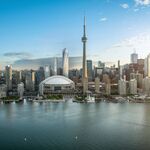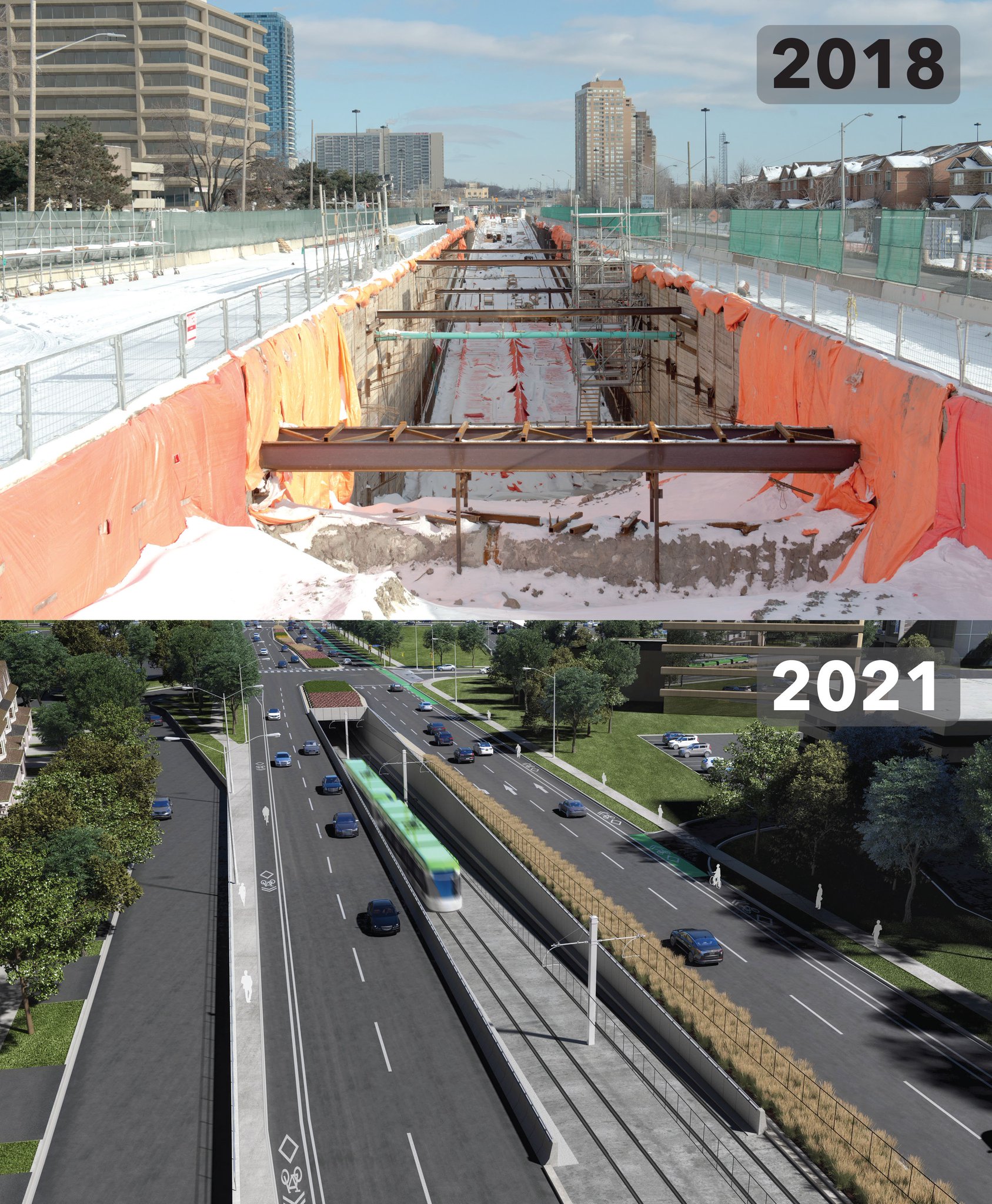You are using an out of date browser. It may not display this or other websites correctly.
You should upgrade or use an alternative browser.
You should upgrade or use an alternative browser.
hw621
Senior Member
Nice pix!
I apologize if we had this discussion earlier in the thread, but if the train is in the middle of the road and subject to the same set of traffic signals as the regular traffic, how is it rapid transit?
Amare
Senior Member
In short, it depends if there is signal priority installed and activated at traffic intersections which would give an LRT vehicle priority to clear an intersection so it wouldnt be held up by red lights. Signal priority activation in this city is dependent on Toronto Transportation Services, who to date have an abysmal record in actually putting this technology to use due to their disinterest in doing so.Nice pix!
I apologize if we had this discussion earlier in the thread, but if the train is in the middle of the road and subject to the same set of traffic signals as the regular traffic, how is it rapid transit?
In essence, without signal priority the at-grade sections of the Crosstown line will function exactly the same way as you see streetcars operating on Spadina and St.Clair. With signal priority, you would see true rapid transit line operation throughout the entire line.
W. K. Lis
Superstar
Along St. Clair, the left turning (single-occupant) vehicles keep giving priority ahead of everyone including the streetcars. The only location where I see streetcars getting priority is when westbound streetcar make a right turn into the Gunns Loop.
Also both St. Clair and Spadina lack the transit specific signals that other jurisdictions use.
Also both St. Clair and Spadina lack the transit specific signals that other jurisdictions use.
hw621
Senior Member
In short, it depends if there is signal priority installed and activated at traffic intersections which would give an LRT vehicle priority to clear an intersection so it wouldnt be held up by red lights. Signal priority activation in this city is dependent on Toronto Transportation Services, who to date have an abysmal record in actually putting this technology to use due to their disinterest in doing so.
In essence, without signal priority the at-grade sections of the Crosstown line will function exactly the same way as you see streetcars operating on Spadina and St.Clair. With signal priority, you would see true rapid transit line operation throughout the entire line.
That is exactly my fear. There is no information from any source confirming that priority signal is being studied or implemented. Chances are we spend billions on enlarged version of streetcars.
The downside of priority signal is that traffic has to stop for the train. If train is frequent (I would assume it will be), traffic will be interrupted.
Last edited:
kotsy
Senior Member
That is exactly my fear. There is no information from any source confirming that priority signal is being studied or implemented. Chances are we spend billions on enlarged version of streetcars.
Huge fear of mine too. I don't exactly have a lot of confidence they will execute this properly. They should've buried the entire line.
hw621
Senior Member
No kidding. I am hoping that someone has any information that might be of certain assurance.Huge fear of mine too. I don't exactly have a lot of confidence they will execute this properly. They should've buried the entire line.
Rainforest
Senior Member
I apologize if we had this discussion earlier in the thread, but if the train is in the middle of the road and subject to the same set of traffic signals as the regular traffic, how is it rapid transit?
Overall, it woudln't be too bad:
1) Dedicated lanes means much less impact from the general traffic congestion.
2) Wide stop spacing - comparable to, or even slightly wider, than the BD subway average (not counting the section of BD east of Vic Park).
3) The central tunneled section will have a positive impact on the average speed. The majority of the riders will use the tunneled section for a portion of their trip.
So, overall the ECLRT could be ranked as about 80% to 90% as "rapid" as the BD subway.
LRT lines running entirely on surface (such as Finch West) is another matter; perhaps they should be ranked as advanced local transit, rather than rapid transit. And that's not necessarily bad, either.
hw621
Senior Member
Thanks for the info. That sounds a little comforting. To be honest I don't have a lot of confidence in the TTC, I am hoping that I am wrong with this one.Overall, it woudln't be too bad:
1) Dedicated lanes means much less impact from the general traffic congestion.
2) Wide stop spacing - comparable to, or even slightly wider, than the BD subway average (not counting the section of BD east of Vic Park).
3) The central tunneled section will have a positive impact on the average speed. The majority of the riders will use the tunneled section for a portion of their trip.
So, overall the ECLRT could be ranked as about 80% to 90% as "rapid" as the BD subway.
LRT lines running entirely on surface (such as Finch West) is another matter; perhaps they should be ranked as advanced local transit, rather than rapid transit. And that's not necessarily bad, either.
Wait a minute, it will be operated by the TTC right?
hw621
Senior Member
Amare
Senior Member
Signal Priority is something that's completely up to the City of Toronto, Metrolinx doesnt have control over the signals in Toronto. However if it came down to it (ie: through complaints), they can force the city to make changes. Although the TTC will operate the line, Metrolinx still owns it and i'm sure they wont allow the TTC to diddle around with it like they do with St.Clair and Spadina.Ok, this LRT fact sheet from the metrolinx website says that there will be priority signals. We shall see what happens.
W. K. Lis
Superstar
The cheapest "transit priority" is the delayed or extended green signal. The signal stays green (usually after the pedestrian signal countdown to "0") as the transit vehicle approaches.
The better "transit priority" is where the transit vehicles uses unique and different transit signals and the general traffic signals goes red in all directions, but gives "go" to the transit vehicle only.
Note the lack of "verbage" signs.
The better "transit priority" is where the transit vehicles uses unique and different transit signals and the general traffic signals goes red in all directions, but gives "go" to the transit vehicle only.
MisterF
Senior Member
Elevating the suburban portions, or just selective grade separations would be a better option IMO. Burying the whole thing would be overkill through the low density sprawl of Scarborough and Etobicoke. Something like what they have in Vancouver or Kuala Lumpur or the London DLR would be quite unobtrusive through those areas. Sadly it doesn't seem like the city wants anything sensible like that.Huge fear of mine too. I don't exactly have a lot of confidence they will execute this properly. They should've buried the entire line.
TheTigerMaster
Superstar
Signal Priority is something that's completely up to the City of Toronto, Metrolinx doesnt have control over the signals in Toronto. However if it came down to it (ie: through complaints), they can force the city to make changes. Although the TTC will operate the line, Metrolinx still owns it and i'm sure they wont allow the TTC to diddle around with it like they do with St.Clair and Spadina.
Diddle with it, in what regard? TTC doesn't control TCP. Metrolinx would need to take up their concerns with Toronto Traffic Services
Last edited:
BMO
Senior Member
That is exactly my fear. There is no information from any source confirming that priority signal is being studied or implemented. Chances are we spend billions on enlarged version of streetcars.
The downside of priority signal is that traffic has to stop for the train. If train is frequent (I would assume it will be), traffic will be interrupted.
Oh, they study and model the line with signal priority to justify spending less on the line and making it an LRT at-grade, but when it comes to actually operating the line I'll bet my top dollar there won't be any signal priority.





